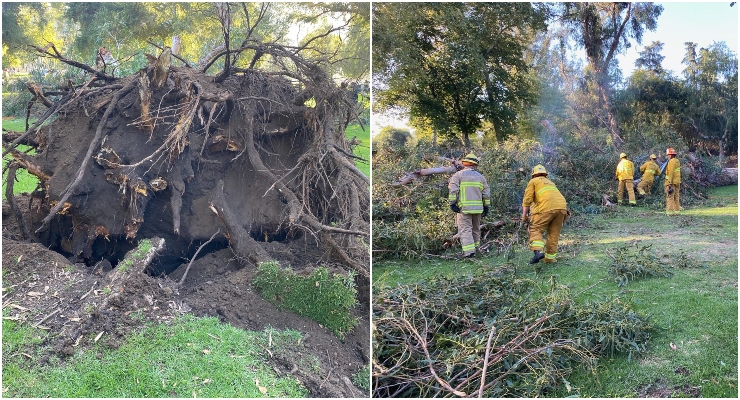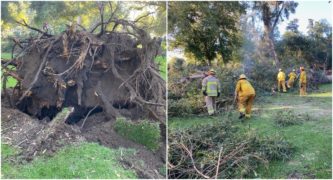
[UPDATED] Researchers from NASA’s Jet Propulsions Laboratory say they were surprised to find carbon dioxide emitted by decaying urban vegetation like trees and grass makes up as much as 20 percent of the C02 emitted by the greater Los Angeles area, as recently published in a study authored by JPL scientists and colleagues.
For Pasadena, one of the greener cities in the area, this means there is an increased potential for urban decay, which could prove harmful later in the future.
The study is based on data collected from three highly sophisticated air-sampling devices placed at three sites across the L.A. basin, JPL said in a written statement.
By analyzing traces of carbon-14 in the samples, researchers were able to determine whether the collected C02 originated from burning fossil fuels, or natural sources such as decaying plant matter, study co-author and JPL Research Scientist Charles Miller said.
“Before we started the experiment, we thought we were going to see almost all anthropogenic — human-caused — emissions, given the volume of traffic in L.A.,” he said. “We were able to find out it wasn’t all due to fossil fuel combustion.”
While the bulk of the excess CO2 could be attributed to fossil fuels and rotting vegetation, “There were additional, small contributions from biofuels, such as ethanol, and from human metabolism,” according to the JPL statement.
The discovery could alter the way scientists think about managing climate change, Miller said.
“One of the reasons that this is important is because as efforts are put in place to manage the amount of carbon dioxide emissions, if we don’t take into account the fact that maybe as much as 20 percent of the fluctuation that we see in Los Angeles and Pasadena is due to the biosphere, due to our vegetation, lawns, trees, et cetera,” according to Miller.
“We might get the wrong idea about how effective limiting traffic would be, or doing other things to reduce the amount of carbon dioxide emissions related to human activity. So that has a big potential impact in the way that we look at and track mitigation of emissions,” he added.
USC conducted a 10-year study, published in 2017, to understand how much tree decay has occurred in the 2000s. Researchers observed the change in greenery cover through Los Angeles County and the correlation of this reduction with single-family homes.
According to the data, Pasadena has the highest percentage of green coverage throughout the 10-year study. Although this has its benefits, USC lecturer Su Jin Lee has his concerns.
“Even though there are a lot of trees currently, if we keep losing them, it’s going to be a problem,” Lee said.
As the more green cover is reduced in Pasadena, it contributes to the CO2 emissions that come from the decaying vegetation.
The data “underscores the complexity of tracking urban carbon emissions,” the JPL statement said.
The C02 emitted by urban greenery varies by season, appearing to track watering in Southern California. The plants absorb the greenhouse gas as they grow, but release it as they die and decompose.
“Carbon-14 dropped sharply in the L.A. basin in July during the study period. That’s when watering urban landscaping — city parks, residential lawns, golf courses, and the like — peaked, causing vigorous growth,” according to the statement. “In turn, the growing plant tissue led to peak carbon-14 absorption, resulting in that sharp drop found in air samples.”
Outside of urban areas, growth and C02 absorption peaks in early spring, coinciding with regional rainfall patterns, the scientists found.
“That was the way that we came to realize that what we were seeing was a signal that was dominated by managed landscapes like grass or trees or golf courses or baseball fields,” according to Miller.
The pattern found in Southern California may well be even more pronounced in urban areas of the tropics and subtropics, which see much greater rates of seasonal plant growth and die-off, “you might find much larger fractions,” Miller said.
The better scientists understand the processes surrounding C02 emission, the better it can be managed, according to JPL.
“Without the vegetation component factored into estimates for total emissions, we will systematically overestimate fossil fuel emissions,” Miller said. “This is important to those responsible for both reporting and mitigation.”
Armed with the new information, more research is now needed, he said. “We need to work with our colleagues in other urban areas around the world to understand these new results.”
The research was published Oct. 27 in the Proceedings of the National Academy of Sciences. The research team consisted of scientists from JPL, the National Oceanic and Atmospheric Administration, and the University of Colorado. It can be found online at pnas.org/content/117/43/26681.














 0 comments
0 comments


